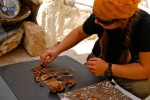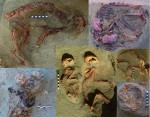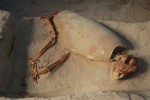Egypt is replete with animal burials. From crocodiles to baboons to falcons to dogs and cats, literally millions of mummified animals have been found in ancient Egyptian tomb complexes from the pre-Dynastic era through the Roman period. These were not companion animals, but sacred animals bred and raised for sacrifice, which is why they have been found in such industrial quantities. They were sold to pilgrims and buried as offerings in religious rituals.
 An excavation in the ancient Red Sea port town of Berenike has unearthed a unique assemblage of animal burials that is not a religious deposit, but rather an actual pet cemetery. The burials have been excavated since 2011 under the direction of Steven Sidebotham in cooperation with the Polish Centre for Mediterranean Archaeology, Warsaw University. Almost 100 intact animal skeletons have been discovered since then on the outskirts of the Early Roman town. Artifacts discovered and the stratigraphy of the site date the pet cemetery to between the late 1st century the first half of the 2nd century A.D.
An excavation in the ancient Red Sea port town of Berenike has unearthed a unique assemblage of animal burials that is not a religious deposit, but rather an actual pet cemetery. The burials have been excavated since 2011 under the direction of Steven Sidebotham in cooperation with the Polish Centre for Mediterranean Archaeology, Warsaw University. Almost 100 intact animal skeletons have been discovered since then on the outskirts of the Early Roman town. Artifacts discovered and the stratigraphy of the site date the pet cemetery to between the late 1st century the first half of the 2nd century A.D.
Berenike was in its heyday then. First founded by Ptolemy II Philadelphus (r. 283-246 B.C.) as a military outpost to protect the trade in African elephants from Ethiopia, by the Early Roman period in the 1st century, it was a key pivot in multiple trade routes connecting India, the Arabian Peninsula and Upper Egypt. The port in the Ptolemaic fort area bustled even harder under the Roman Empire, eventually becoming its own district with its own dedicated prefect.
 When animal burials began at the site in the 1st century, the area was an undeveloped ground between the town and the Ptolemaic fort. It’s part of a large zone dubbed by archaeologists the “Early Roman trash dump.” The garbage proved helpful because the most recent burials had to be dug into the trash which dated them to the 2nd century.
When animal burials began at the site in the 1st century, the area was an undeveloped ground between the town and the Ptolemaic fort. It’s part of a large zone dubbed by archaeologists the “Early Roman trash dump.” The garbage proved helpful because the most recent burials had to be dug into the trash which dated them to the 2nd century.
 The vast majority of the animals buried — 86 complete skeletons — were cats. Three of them were double burials and all of those double cat burials contained one adult and one juvenile feline. The next most popular burial subject was the dog, with nine skeletons unearthed. Monkeys — three grivets, one vervet monkey, one olive baboon — came third. Few grave goods have been found, although some of the animals were buried with accessories like iron collars found on three cats and a vervet monkey, and two cats found with an ostrich eggshell bead by their necks.
The vast majority of the animals buried — 86 complete skeletons — were cats. Three of them were double burials and all of those double cat burials contained one adult and one juvenile feline. The next most popular burial subject was the dog, with nine skeletons unearthed. Monkeys — three grivets, one vervet monkey, one olive baboon — came third. Few grave goods have been found, although some of the animals were buried with accessories like iron collars found on three cats and a vervet monkey, and two cats found with an ostrich eggshell bead by their necks.
Study author Marta Osypińska writes in the journal Antiquity:
Most of the well-preserved, complete animal skeletons are free of any pathologies. Particular attention has been paid to any evidence for the intentional killing of the animals — a practice known from the Nile Valley animal mummies — but there is no indication of this in the Berenike assemblage.
On the basis of the type of burial, the absence of mummification, the diverse species list and the absence of human inhumations, it is suggested that the Berenike cemetery reflects different intentions and cultural practices compared to the Nile Valley animal deposits. In my opinion, the described features suggest that the Berenike finds should be interpreted as a cemetery of house pets rather than deposits related to sacred or magical rites.
 Romans were known to be deeply bonded to their dogs. Tombstones dedicated to a beloved pup have been found all over the Empire. One of the dogs buried at Berenike burials, a young moolosser-type dog that is so much larger and more massive than the local dogs that it was probably imported from Rome or Greece, died of osteosarcoma, the earliest known example of the cancer in dogs. Its last meal was fish and goat meat. The owner placed its body in a basket and covered it with broken pottery to create a sort of homemade sarcophagus effect.
Romans were known to be deeply bonded to their dogs. Tombstones dedicated to a beloved pup have been found all over the Empire. One of the dogs buried at Berenike burials, a young moolosser-type dog that is so much larger and more massive than the local dogs that it was probably imported from Rome or Greece, died of osteosarcoma, the earliest known example of the cancer in dogs. Its last meal was fish and goat meat. The owner placed its body in a basket and covered it with broken pottery to create a sort of homemade sarcophagus effect.
The tenderness and thoughtfulness evinced in these burials argues against the animals having been dumped on the trash heap, nor do they have the typical twisted necks of the animals killed for mummification and sacrifice.
Another specific feature of the Berenike cemetery is the very high percentage of cats. These animals were deeply respected throughout the pre-Roman periods, but such practices were never adopted by other societies. In Roman Europe, the cat initially became popular in the first century AD and its spread was aided by the Roman army (Toynbee 1973). Thus, could we suspect that the eclectic evidence (both Egyptian and Roman) from Berenike reflects the adoption of the cat as a pet in this multicultural community? Naturally, there are plenty of reasons for keeping cats in a port-town, but the general segregation of the kitten and adult inhumations suggests a more complex relationship than pragmatic coexistence.